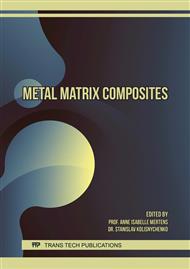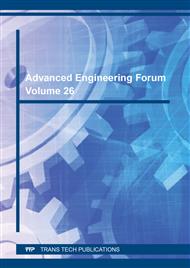p.1
p.9
p.22
p.33
p.41
p.53
p.67
p.74
p.87
Microstructural Evolution of Metal Matrix Composites Formed by Laser Deposition of Ti-6Al-4V Wire and WC-W2C Powder
Abstract:
In this paper, the microstructural evolution of the composite formed by fibre laser deposition of Ti-6Al-4V wire and WC-W2C powder was investigated and reported. Nine single tracks were deposited using combinations of four laser processing parameters (laser power, traverse speed, wire feed rate and powder feed rate) with each having three levels based on Taguchi design of experiments. The samples of the deposited composites were subjected to microstructural examinations using scanning electron microscopy with energy dispersive spectroscopy and X-ray Diffractometry, and microhardness tests. The resultant microstructure is characterised by uniform distribution of the reinforcement particles (WC-W2C) and dispersion of in-situ synthesised TiC and W solid solution precipitates in a β-stabilised Ti matrix. The TiC precipitates have blocky and fine eutectic morphologies, while the W solid solution precipitates have blocky and leaf-like equiaxed morphologies. The retained W composition in the β-Ti was found to range from 7.5-9 at%, and it helped to β-stabilise the matrix which was considered beneficial for the composite matrix to retain its ductility. Increasing laser power was found to decrease the amount of W retained in the Ti matrix which resulted in a lower cooling rate, favourable for the nucleation of W solid solution. The uniform dispersion of the TiC and W solid solutions in the β-Ti matrix phase has significantly enhanced its hardness which ranged from 455-543 HV0.3. It is anticipated that the composite formed will possess excellent wear resistance and contact deformation characteristics.
Info:
Periodical:
Pages:
22-32
Citation:
Online since:
February 2018
Authors:
Keywords:
Price:
Сopyright:
© 2018 Trans Tech Publications Ltd. All Rights Reserved
Share:
Citation:



